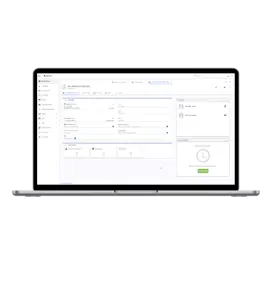Quick links
Performance Management in Manufacturing – ERP
Performance Management in Manufacturing – ERP
4 Jun 2020
Aptean Staff Writer
What is Performance Management?
The organization and measurement of work to achieve the best possible results.
Performance management is an approach to helping a business achieve its goals through the planning of critical performance targets and the measurement of progress towards those targets. It can be, and often is, applied at every level of the business.
From Top Floor to Shop Floor
At its top level, performance management includes strategic plans and the targets needed to achieve those plans. At its most detailed level, it includes targets for the manufacturing operations with such key indicators such as uptime, defects per run, cycle times and others. Performance management lets you drive results through focused execution of strategies across all levels of the business. This gives increased visibility and control – something typically lacking because of fragmented data and systems.
Performance management helps a company make decisions and then execute them. It can be the backbone that connects all the activities of the business into a system of accomplishing the high level goals that management wants to achieve, and one source of the truth. The approach allows you to build the high level goals of the business, and then to set supporting goals all the way down to individual department metrics.
Department Silos
It also can provide the shared insights for shop level personnel to understand their contribution to higher level goals, and empower these employees to perform better. Today’s manufacturers are often structured with disconnected silos, which makes it difficult to avoid conflicting activities, with a potential negative impact on overall company goals. Additionally, manual department forms, or spreadsheets are difficult to consolidate in order to provide insights to higher level goals.
Feedback Now!
Performance management is a real time activity that provides instant feedback when certain activities are not meeting their goals, and to correct them before they negatively impact the organization. Goals can also be easily updated to accommodate new facts, and then reviewed as to their effect on higher level goals. Performance management also establishes alerts and exception reporting to allow quick reactions to minute by minute deviations from targets.
Focus, Focus, Focus
Performance management also provides a focus for the organization on the most important factors to success. Key performance indicators (KPIs) are set only for the most critical areas that most impact the results of the organization. This helps to provide a visibility into the actions that make a direct difference in accomplishing critical goals
The Drivers of Performance Management
Performance management can give you a deep understanding of the levers affecting performance on any dimension of your business- production, supply chain, sales, product lines, customers and channels. Performance management delivers visibility into the true drivers impacting your bottom line. Understanding these drivers can also provide the basis for implementing continuous improvement programs in the organization.
ERP – A Foundation for Performance Management
The biggest advantage of an ERP system is the real-time capability…the ability to see what is going on within your company as it happens. You have access to literally thousands of fields of information, and millions of transactions of activity. You can look up information that spans departments so you can see the big picture. But, now that you have this mountain of critical information, how do focus on the key pieces of information that make the difference between success and failure. How can you be notified of the key changes in your business where a quick reaction can make a substantial difference? The answer is performance management.
More on Performance Management – Key Insights, Right Now
Aligning With Business Purpose
The overall goal of performance management is to align the top level goals of the business to the complex network of activities within the business. Top level goals can include items such as customer satisfaction, product variety, quality and a host of others. For success, it is imperative that all the activities in the business point and execute towards these goals.
Achieving Operational Success
Another overriding goal of performance management to optimize of all the sub processes within the business. Developing feedback for each of the operations can start the incremental process improvements necessary for organization success.
It is critical to determine the key performance indicators for each role or operation, and start the process of unit improvement. Measuring each role or operation can also provide the motivational push to initiate incremental improvements.
ERP Integration
The first step to measure all activities in the operations is to collect data about all the activities. ERP manufacturing systems have now integrated all the business management functions, including planning, inventory/materials management, engineering, order processing, manufacturing, purchasing, accounting and finance, human resources, and more. Fortunately, the latest ERP manufacturing systems not only collect all this information, but provide an IT structure of how one activity relates to another, thereby allowing a view that crosses departments.
For example, a report of production orders and the associated raw material status is easy to produce, because the relationship of both has been pre-defined. You can imagine the difficulty of creating the report if the linkage between them did not exist (as in manual or piece meal systems).
Using Data as a Strategic Asset
Performance management provides the insights needed to exceed the competition. You can only imagine an organization that aligns with each individual’s opinions versus one that aligns to the goals of the whole. Performance management can align all these processes into the company-wide goals, and achieve a strategic advantage.
A Simple Example
You have decided that your strategic advantage is to provide the shortest lead times for your customer orders, even if your prices are a little higher. You want to appeal to customers who need quick turnaround for whatever reason. You set this as a strategic goal, and now want to set some focused KPIs to accomplish it. Your KPIs would need to focus on achieving your goal, and would probably emphasize such things as material lead time performance, shop queue time, machine cycle times, and the like. Your employees would then know what you want to emphasize, and can focus their attention on improving those areas. Other goals would exist, but would always be secondary to your lead time strategy.
Starting With a Goal
Key performance indicators (KPIs) are the targets that are set to help an organization define and measure progress. KPIs must be quantifiable, and be core-critical success factors of the organization. They should also reflect the organization’s goals.
There are literally thousands of measures (KPI’s) that could be implemented. As with any complex topic, the key to success is finding the few key measurements that impact the business the most. Some of the best measurements will be obvious, but others may need to be uncovered by those experienced in implementing performance management in your industry.
Some High Level Common Goals
On-time delivery
Quality improvement
Flexibility
Reduced inventory
Shorter lead times
Improved productivity
Information sharing
Continuous improvement
Cost reduction
Demand reliability
Profitability by unit, product, or area
Market share
Example KPI’s in Manufacturing
The KPIs will be used to monitor production at a glance. In selecting these KPIs, it is important to limit the number of KPIs in order to focus on those that are essential for the overall organization to reach its goals.
These production and operational level metrics provide the basis for higher level KPIs, which finally then provide performance measurement to strategic goals. At any time, the higher level KPIs can be drilled down to the lower level KPIs which comprise it, in order to identify the root cause of problem areas.
Shop Floor KPIs:
Operation Due Dates Met
Material Usage Variances
Cost of Scrap & Re-work
Operator Efficiency %
Labor Rate Variances
Quality KPIs:
Measurement of Corrective Actions to Customer Issues
Reduction of Returned Materials
Lead Time Reduction
Conformance with Outside/Government Regulations
Maintenance KPIs:
Critical Machine Availability
Downtime
MTBF (Mean Time Between Failures)
Maintenance/Dept Budget vs. Actual
Maintenance Inventory Levels
Delivering Timely, Actionable Information
The final piece of the performance management puzzle involves delivering the business insights to the decision makers within the timeframe for action. This becomes near impossible for all but computerized systems. For those with modern systems, it is easy to provide real-time visibility into key operating performance targets, and to react as crucial changes occur.
Performance Management – Characteristics of Great Tools
Dashboards
Performance management requires fast information that is easy to grasp, understand, and react to. Productive tools must provide focused dashboards with illustrative graphics that make the results quick to read and fast to comprehend.
Roles
Since performance management seeks to connect and maximize the results of sub processes towards the whole, it is also important that your solution is able to organize by the roles and operations of the business. A robust solution will allow the measurement by roles, such as production scheduler, shop manager, etc.; while also allowing measurement by standard operations such as cutting, stamping and assembly. Each role can view the exact KPIs and dashboards that pertain to their responsibilities in accomplishing company goals.
Alerts and Exception Reporting
Performance management is not only based on historical reporting that facilitates corrective action, but is also predicated on the real time reporting that allows immediate problem identification and correction. This reporting often takes the form of alerts and exception reporting that can notify appropriate parties immediately when deviations occur. This can also help to prevent further part production when quality standards aren’t met.
Fit for the Business
Big company tools can are too complicated for the mid-sized business. High level statistics and IT type commands will only discourage use of the tools for your front line people.
Easy to Use
If your people can’t use the software, it can’t benefit your organization. The screens need to be intuitive, the graphs easy to understand.
Integrated With Your Data
This is probably the most important point. Only big company IT departments can build internal tools that cross different vendor applications. Your mid-sized integrated solution should come with pre-established data relationships, leaving you with easy pick and click creation of your information.
Access to Your Data Without the IT Department
A good tool will always provide the connections to your data, without any programming by your IT department. You can simply select the information you want, and then easily create exciting KPI reports and graphs.
Flexibility
Good tools will offer flexibility in the creation of reports and graphs. You should never be limited to canned reports, or graphs. The tool should allow you the flexibility to obtain every report you want, but shouldn’t take an IT degree to program it. Want to add a different field, or try a different format of a graph, or change time periods? Your tool should make this easy.
Drill Down
Good tools also provide the ability to immediately drill into the details on any KPI report or graph produced. This gives a deeper insight into the details, without the tedious exercise of digging through journals or records.
KPI’s by Time Frame
KPI’s can refer to various different time periods, which are easily specified in good performance management tools. This easily accommodates special financial periods and special shop calendars.
Create and Reuse Reports
If you have created a report that you would like to reuse, you should be able to store that template, and use it again and again.
Accessible at the Right Levels
Lastly, since KPI’s can apply to every level of the business, it is important that the reports and graphs be available to the right person, with all the protections to prevent others from viewing items that are beyond their scope of responsibility.
Summary
A great performance management tool can be invaluable to improving an organization’s results at every level. Individual tasks can be aligned with business strategy to produce competition beating results. And, with today’s ERP integration, creating an environment of feedback is easier than ever. Performance management will provide the actionable information to accelerate.
Ready to learn more? Our ERP solution experts are ready and willing to answer all your questions and help you get started on selecting the right solution for your business.
Related Content


Request a callback from a manufacturing ERP expert
We’ve got the specialised ERP solutions you need to conquer your industry challenges.






